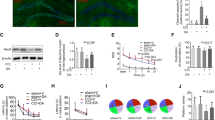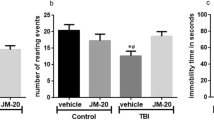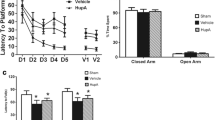Abstract
Driving under methylenedioxymethamphetamine (MDMA) influence increases the risk of being involved in a car accident, which in turn can lead to traumatic brain injury. The behavioral deficits after traumatic brain injury (TBI) are closely connected to dopamine pathway dysregulation. We have previously demonstrated in mice that low MDMA doses prior to mTBI can lead to better performances in cognitive tests. The purpose of this study was to assess in mice the changes in the dopamine system that occurs after both MDMA and minimal traumatic brain injury (mTBI). Experimental mTBI was induced using a concussive head trauma device. One hour before injury, animals were subjected to MDMA. Administration of MDMA before injury normalized the alterations in tyrosine hydroxylase (TH) levels that were observed in mTBI mice. This normalization was also able to lower the elevated dopamine receptor type 2 (D2) levels observed after mTBI. Brain-derived neurotrophic factor (BDNF) levels did not change following injury alone, but in mice subjected to MDMA and mTBI, significant elevations were observed. In the behavioral tests, haloperidol reversed the neuroprotection seen when MDMA was administered prior to injury. Altered catecholamine synthesis and high D2 receptor levels contribute to cognitive dysfunction, and strategies to normalize TH signaling and D2 levels may provide relief for the deficits observed after injury. Pretreatment with MDMA kept TH and D2 receptor at normal levels, allowing regular dopamine system activity. While the beneficial effect we observe was due to a dangerous recreational drug, understanding the alterations in dopamine and the mechanism of dysfunction at a cellular level can lead to legal therapies and potential candidates for clinical use.







Similar content being viewed by others
References
Ahmed RH, Shaw KE, McAloon RL, Olugbade YT, Ghuman SA, Ehrenberg KM, Chowdhury IH, Cheng JP, Hoffman AN, Zafonte RD, Hernandez TD, Kline AE (2010) The adverse effect on spatial learning following chronic administration of haloperidol or risperidone after experimental brain trauma is long-lasting. Society for Neuroscience Abstract Viewer and Itinerary Planner 40
Alexander MP (1995) Mild traumatic brain injury—pathophysiology, natural-history, and clinical management. Neurology 45:1253–1260
Andriessen T, Jacobs B, Vos PE (2010) Clinical characteristics and pathophysiological mechanisms of focal and diffuse traumatic brain injury. J Cell Mol Med 14:2381–2392
Assaf F, Fishbein M, Gafni M, Keren O, Sarne Y (2012) Pre- and post-conditioning treatment with an ultra-low dose of Delta(9)-tetrahydrocannabinol (THC) protects against pentylenetetrazole (PTZ)-induced cognitive damage. Behav Brain Res 220:194–201
Bales JW, Wagner AK, Kline AE, Dixon CE (2009) Persistent cognitive dysfunction after traumatic brain injury: a dopamine hypothesis. Neurosci Biobehav Rev 33:981–1003
Baratz R, Rubovitch V, Frenk H, Pick CG (2010) The influence of alcohol on behavioral recovery after mTBI in mice. J Neurotrauma 27:555–563
Bazarian JJ, McClung J, Shah MN, Cheng YT, Flesher W, Kraus J (2005) Mild traumatic brain injury in the United States, 1998–2000. Brain Inj 19:85–91
Beaulieu J-M, Del’guidice T, Sotnikova TD, Lemasson M, Gainetdinov RR (2011) Beyond cAMP: the regulation of Akt and GSK3 by dopamine receptors. Front Mol Neurosci 4:38
Bullinger M (2002) Quality of life in patients with traumatic brain injury—basic issues, assessment and recommendations—results of a consensus meeting. Restor Neurol Neurosci 20:111–124
Camarero J, Sanchez V, O’Shea E, Green AR, Colado MI (2002) Studies, using in vivo microdialysis, on the effect of the dopamine uptake inhibitor GBR 12909 on 3,4-methylenedioxymethamphetamine (‘ecstasy’)-induced dopamine release and free radical formation in the mouse striatum. J Neurochem 81:961–972
Cassol OJ Jr, Comim CM, Constantino LS, Rosa DVF, Mango LAV, Stertz L, Kapczinski F, Romano-Silva MA, Quevedo J, Dal-Pizzol F (2011) Acute low dose of MK-801 prevents memory deficits without altering hippocampal DARPP-32 expression and BDNF levels in sepsis survivor rats. J Neuroimmunol 230:48–51
Connor B, Dragunow M (1998) The role of neuronal growth factors in neurodegenerative disorders of the human brain. Brain Res Rev 27:1–39
Connor TJ, Kelly JP, McGee M, Leonard BE (2000) Methylenedioxymethamphetamine (MDMA; ecstasy) suppresses IL-1 beta and TNF-alpha secretion following an in vivo lipopolysaccharide challenge. Life Sci 67:1601–1612
Connor TJ, Harkin A, Kelly JP (2005) Methylenedioxymethamphetamine suppresses production of the proinflammatory cytokine tumor necrosis factor-alpha independent of a beta-adrenoceptor-mediated increase in interleukin-10. J Pharmacol Exp Ther 312:134–143
Cools R, D’Esposito M (2011) Inverted-U-shaped dopamine actions on human working memory and cognitive control. Biol Psychiatry 69:E113–E125
Davis KL, Kahn RS, Ko G, Davidson M (1991) Dopamine in schizophrenia—a review and reconceptualization. Am J Psychiatr 148:1474–1486
Dellu F, Mayo W, Cherkaoui J, Lemoal M, Simon H (1992) A 2-trial memory task with automated recording—study in young and aged rats. Brain Res 588:132–139
Di Cara B, Maggio R, Aloisi G, Rivet J-M, Lundius EG, Yoshitake T, Svenningsson P, Brocco M, Gobert A, De Groote L, Cistarelli L, Veiga S, De Montrion C, Rodriguez M, Galizzi J-P, Lockhart BP, Coge F, Boutin JA, Vayer P, Verdouw PM, Groenink L, Millan MJ (2011) Genetic deletion of trace amine 1 receptors reveals their role in auto-inhibiting the actions of ecstasy (MDMA). J Neurosci 31:16928–16940
Dix SL, Aggleton JP (1999) Extending the spontaneous preference test of recognition: evidence of object-location and object-context recognition. Behav Brain Res 99:191–200
Dixon CE, Kraus MF, Kline AE, Ma XC, Yan HQ, Griffith RG, Wolfson BM, Marion DW (1999) Amantadine improves water maze performance without affecting motor behavior following traumatic brain injury in rats. Restor Neurol Neurosci 14:285–294
Edut S, Rubovitch V, Schreiber S, Pick CG (2011) The intriguing effects of ecstasy (MDMA) on cognitive function in mice subjected to a minimal traumatic brain injury (mTBI). Psychopharmacology 214:877–889
Gerstenbrand F, Stepan CA (2001) Mild traumatic brain injury. Brain Inj 15:95–97
Granado N, O’Shea E, Bove J, Vila M, Colado MI, Moratalla R (2008) Persistent MDMA-induced dopaminergic neurotoxicity in the striatum and substantia nigra of mice. J Neurochem 107:1102–1112
Granado N, Ares-Santos S, Oliva I, O’Shea E, Martin ED, Isabel Colado M, Moratalla R (2011) Dopamine D2-receptor knockout mice are protected against dopaminergic neurotoxicity induced by methamphetamine or MDMA. Neurobiol Dis 42:391–403
Green AR, Mechan AO, Elliott JM, O’Shea E, Colado MI (2003) The pharmacology and clinical pharmacology of 3,4-methylenedioxymethamphetamine (MDMA, “ecstasy”). Pharmacol Rev 55:463–508
Griesbach GS, Hovda DA, Gomez-Pinilla F (2009a) Exercise-induced improvement in cognitive performance after traumatic brain injury in rats is dependent on BDNF activation. Brain Res 1288:105–115
Griesbach GS, Sutton RL, Hovda DA, Ying Z, Gomez-Pinilla F (2009b) Controlled contusion injury alters molecular systems associated with cognitive performance. J Neurosci Res 87:795–805
Haavik J, Toska K (1998) Tyrosine hydroxylase and Parkinson’s disease. Mol Neurobiol 16:285–309
Hamm RJ, Lyeth BG, Jenkins LW, Odell DM, Pike BR (1993) Selective cognitive impairment following traumatic brain injury in rats. Behav Brain Res 59:169–173
Han X, Yang N, Xu Y, Zhu J, Chen Z, Liu Z, Dang G, Song C (2011) Simvastatin treatment improves functional recovery after experimental spinal cord injury by upregulating the expression of BDNF and GDNF. Neurosci Lett 487:255–259
Hewitt KE, Green AR (1994) Chlormethiazole, dizocilpine and haloperidol prevent the degeneration of serotonergic nerve-terminals induced by administration of MDMA (ecstasy) to rats. Neuropharmacology 33:1589–1595
Hoffman AN, Cheng JP, Zafonte RD, Kline AE (2008) Administration of haloperidol and risperidone after neurobehavioral testing hinders the recovery of traumatic brain injury-induced deficits. Life Sci 83:602–607
Holm L, Cassidy JD, Carroll LJ, Borg J (2005) Summary of the WHO Collaborating Centre for Neurotrauma Task Force on mild traumatic brain injury. J Rehabil Med 37:137–141
Hutson CB, Lazo CR, Mortazavi F, Giza CC, Hovda D, Chesselet M-F (2011) Traumatic brain injury in adult rats causes progressive nigrostriatal dopaminergic cell loss and enhanced vulnerability to the pesticide paraquat. J Neurotrauma 28:1783–1801
Kaplan GB, Vasterling JJ, Vedak PC (2010) Brain-derived neurotrophic factor in traumatic brain injury, post-traumatic stress disorder, and their comorbid conditions: role in pathogenesis and treatment. Behav Pharmacol 21:427–437
Kehagia AA, Murray GK, Robbins TW (2010) Learning and cognitive flexibility: frontostriatal function and monoaminergic modulation. Curr Opin Neurobiol 20:199–204
Kellendonk C, Simpson EH, Polan HJ, Malleret G, Vronskaya S, Winiger V, Moore H, Kandel ER (2006) Transient and selective overexpression of dopamine D2 receptors in the striatum causes persistent abnormalities in prefrontal cortex functioning. Neuron 49:603–615
Kline AE, Massucci JL, Marion DW, Dixon CE (2002) Attenuation of working memory and spatial acquisition deficits after a delayed and chronic bromocriptine treatment regimen in rats subjected to traumatic brain injury by controlled cortical impact. J Neurotrauma 19:415–425
Kline AE, Massucci JL, Ma XC, Zafonte RD, Dixon CE (2004) Bromocriptine reduces lipid peroxidation and enhances spatial learning and hippocampal neuron survival in a rodent model of focal brain trauma. J Neurotrauma 21:1712–1722
Kline AE, Hoffman AN, Cheng JP, Zafonte RD, Massucci JL (2008) Chronic administration of antipsychotics impede behavioral recovery after experimental traumatic brain injury. Neurosci Lett 448:263–267
Kobori N, Clifton GL, Dash PK (2006) Enhanced catecholamine synthesis in the prefrontal cortex after traumatic brain injury: implications for prefrontal dysfunction. J Neurotrauma 23:1094–1102
Li Y-C, Gao W-J (2011) GSK-3 beta activity and hyperdopamine-dependent behaviors. Neurosci Biobehav Rev 35:645–654
Li B, Arime Y, Hall FS, Uhl GR, Sora I (2010) Impaired spatial working memory and decreased frontal cortex BDNF protein level in dopamine transporter knockout mice. Eur J Pharmacol 628:104–107
Li Y-C, Kellendonk C, Simpson EH, Kandel ER, Gao W-J (2011) D2 receptor overexpression in the striatum leads to a deficit in inhibitory transmission and dopamine sensitivity in mouse prefrontal cortex. Proc Natl Acad Sci U S A 108:12107–12112
Loane DJ, Faden AI (2010) Neuroprotection for traumatic brain injury: translational challenges and emerging therapeutic strategies. Trends Pharmacol Sci 31:596–604
Ma X, Yan HQ, Kline AE, Yu J, Marion DW, Dixon CE (2000) Upregulation of tyrosine hydroxylase (TH) protein in rat frontal cortex after chronic traumatic brain injury. J Neurotrauma 17:951
McIntosh TK, Yu T, Gennarelli TA (1994) Alterations in regional brain catecholamine concentrations after experimental brain injury in the rat. J Neurochem 63:1426–1433
Mehta MA, Gumaste D, Montgomery AJ, McTavish SFB, Grasby PM (2005) The effects of acute tyrosine and phenylalanine depletion on spatial working memory and planning in healthy volunteers are predicted by changes in striatal dopamine levels. Psychopharmacology 180:654–663
Meisner F, Scheller C, Kneitz S, Sopper S, Neuen-Jacob E, Riederer P, ter Meulen V, Koutsilieri E (2008) Memantine upregulates BDNF and prevents dopamine deficits in SIV-infected macaques: a novel pharmacological action of memantine. Neuropsychopharmacology 33:2228–2236
Messier C (1997) Object recognition in mice: improvement of memory by glucose. Neurobiol Learn Mem 67:172–175
Milman A, Rosenberg A, Weizman R, Pick CG (2005) Mild traumatic brain injury induces persistent cognitive deficits and behavioral disturbances in mice. J Neurotrauma 22:1003–1010
Pan WH, Kastin AJ, Rigai T, McLay R, Pick CG (2003) Increased hippocampal uptake of tumor necrosis factor alpha and behavioral changes in mice. Exp Brain Res 149:195–199
Prigatano GP, Gale SD (2011) The current status of postconcussion syndrome. Curr Opin Psychiatry 24:243–250
Ryan LM, Warden DL (2003) Post concussion syndrome. Int Rev Psychiatry 15:310–316
Saatman KE, Duhaime A-C, Bullock R, Maas AIR, Valadka A, Manley GT (2008) Classification of traumatic brain injury for targeted therapies. J Neurotrauma 25:719–738
Savitz J, Solms M, Ramesar R (2006) The molecular genetics of cognition: dopamine, COMT and BDNF. Genes Brain Behav 5:311–328
Schmidt CJ, Black CK, Taylor VL (1990) Antagonism of the neurotoxicity due to a single administration of methylenedioxymethamphetamine. Eur J Pharmacol 181:59–70
Seeman P, Schwarz J, Chen JF, Szechtman H, Perreault M, McKnight GS, Roder JC (2006) Psychosis pathways converge via D2(high) dopamine receptors. Synapse 60:319–346
Shin SS, Bray ER, Zhang CQ, Dixon CE (2010) Alterations in striatal dopamine synthesis and release at 1 day and 1 week after traumatic brain injury in rats. Society for Neuroscience Abstract Viewer and Itinerary Planner 40
Shin SS, Bray ER, Zhang CQ, Dixon CE (2011) Traumatic brain injury reduces striatal tyrosine hydroxylase activity and potassium-evoked dopamine release in rats. Brain Res 1369:208–215
Sil’kis IG (2002) A possible mechanism for the dopamine-evoked synergistic disinhibition of thalamic neurons via the “direct” and “indirect” pathways in the basal ganglia. Neurosci Behav Physiol 32:205–212
Simpson EH, Kellendonk C, Kandel E (2010) A possible role for the striatum in the pathogenesis of the cognitive symptoms of schizophrenia. Neuron 65:585–596
Sumi-Ichinose C, Ichinose H, Ikemoto K, Nomura T, Kondo K (2010) Advanced research on dopamine signaling to develop drugs for the treatment of mental disorders: regulation of dopaminergic neural transmission by tyrosine hydroxylase protein at nerve terminals. J Pharmacol Sci 114:17–24
Takahashi H, Higuchi M, Suhara T (2006) The role of extrastriatal dopamine D2 receptors in schizophrenia. Biol Psychiatry 59:919–928
Tang YP, Noda Y, Nabeshima T (1997) Involvement of activation of dopaminergic neuronal system in learning and memory deficits associated with experimental mild traumatic brain injury. Eur J Neurosci 9:1720–1727
Taniguchi N, Shinoda Y, Takei N, Nawa H, Ogura A, Tominaga-Yoshino K (2006) Possible involvement of BDNF release in long-lasting synapse formation induced by repetitive PKA activation. Neurosci Lett 406:38–42
Tio D, Nair S, Taylor A, Hovda D, Griesbach G (2011) Differential effects of voluntary and forced exercise after mild traumatic brain injury on BDNF and stress responses. J Neurotrauma 28:A80–A80
Valjent E, Bertran-Gonzalez J, Bowling H, Lopez S, Santini E, Matamales M, Bonito-Oliva A, Herve D, Hoeffers C, Klann E, Girault J-A, Fisone G (2011) Haloperidol regulates the state of phosphorylation of ribosomal protein S6 via activation of PKA and phosphorylation of DARPP-32. Neuropsychopharmacology 36:2561–2570
Wagner AK, Chen XB, Kline AE, Li YM, Zafonte RD, Dixon CE (2005a) Gender and environmental enrichment impact dopamine transporter expression after experimental traumatic brain injury. Exp Neurol 195:475–483
Wagner AK, Sokoloski JE, Ren D, Chen X, Khan AS, Zafonte RD, Michael AC, Dixon CE (2005b) Controlled cortical impact injury affects dopaminergic transmission in the rat striatum. J Neurochem 95:457–465
Wagner AK, Kline AE, Ren DX, Willard LA, Wenger MK, Zafonte RD, Dixon CE (2007a) Gender associations with chronic methylphenidate treatment and behavioral performance following experimental traumatic brain injury. Behav Brain Res 181:200–209
Wagner AK, Ren DX, Conley YP, Ma XC, Kerr ME, Zafonte RD, Puccio AM, Marion DW, Dixon CE (2007b) Sex and genetic associations with cerebrospinal fluid dopamine and metabolite production after severe traumatic brain injury. J Neurosurg 106:538–547
Wagner AK, Drewencki LL, Chen X, Santos FR, Khan AS, Harun R, Torres GE, Michael AC, Dixon CE (2009) Chronic methylphenidate treatment enhances striatal dopamine neurotransmission after experimental traumatic brain injury. J Neurochem 108:986–997
Weinberger DR, Berman KF, Illowsky BP (1988) Physiological dysfunction of dorsolateral prefrontal cortex in schizophrenia. III. A new cohort and evidence for a monoaminergic mechanism. Arch Gen Psychiatry 45:609–615
Whyte J (2006) The effects of methylphenidate on attention deficits after traumatic brain injury: a multidimensional assessment. Brain Cogn 60:191–191
Whyte J, Hart T, Vaccaro M, Grieb-Neff P, Risser A, Polansky M, Coslett HB (2004) Effects of methylphenidate on attention deficits after traumatic brain injury—a multidimensional randomized controlled trial. Am J Phys Med Rehabil 83:401–420
Williams WH, Potter S, Ryland H (2010) Mild traumatic brain injury and postconcussion syndrome: a neuropsychological perspective. J Neurol Neurosurg Psychiatry 81:1116–1122
Wotherspoon G, Savery D, Priestley JV, Rattray M (1994) Repeated administration of MDMA down-regulates preprocholecystokinin mRNA expression but not tyrosine hydroxylase mRNA expression in neurones of the rat substantia nigra. Brain Res Mol Brain Res 25:34–40
Wu HT, Lu DY, Jiang H, Xiong Y, Qu CS, Li B, Mahmood A, Zhou D, Chopp M (2008) Simvastatin-mediated upregulation of VEGF and BDNF, activation of the PI3K/Akt pathway, and increase of neurogenesis are associated with therapeutic improvement after traumatic brain injury. J Neurotrauma 25:130–139
Yamada K, Nabeshima T (2003) Brain-derived neurotrophic factor/TrkB signaling in memory processes. J Pharmacol Sci 91:267–270
Yan HQ, Kline AE, Ma XC, Hooghe-Peters EL, Marion DW, Dixon CE (2001) Tyrosine hydroxylase, but not dopamine beta-hydroxylase, is increased in rat frontal cortex after traumatic brain injury. Neuroreport 12:2323–2327
Yan HQ, Kline AE, Ma XC, Li YM, Dixon CE (2002) Traumatic brain injury reduces dopamine transporter protein expression in the rat frontal cortex. Neuroreport 13:1899–1901
Yan HO, Li Y, Ma X, Dixon CE (2004) Adenosine A2A and dopamine D2 receptors interactions in rat striatum after traumatic brain injury. J Neurotrauma 21:P302
Yan HQ, Ma XC, Li YM, Bales J, Dixon CE (2007a) Effect of traumatic brain injury on the expression of dopamine- and cAMP-regulated phosphoprotein, Mr 32 kDA phosphorylation at threonine 34 (pDARPP32-T34) in rat striatum. J Neurotrauma 24:P182
Yan HQ, Ma X, Chen X, Li Y, Shao L, Dixon CE (2007b) Delayed increase of tyrosine hydroxylase expression in rat nigrostriatal system after traumatic brain injury. Brain Res 1134:171–179
Zhan L, Wang T, Li W, Xu ZC, Sun W, Xu E (2010) Activation of Akt/FoxO signaling pathway contributes to induction of neuroprotection against transient global cerebral ischemia by hypoxic pre-conditioning in adult rats. J Neurochem 114:897–908
Zhang HX, Du GH, Zhang JT (2003) Ischemic pre-conditioning preserves brain mitochondrial functions during the middle cerebral artery occlusion in rat. Neurol Res 25:471–476
Zohar O, Schreiber S, Getslev V, Schwartz JP, Mullins PG, Pick CG (2003) Closed-head minimal traumatic brain injury produces long-term cognitive deficits in mice. Neuroscience 118:949–955
Acknowledgments
This study was supported (in part) by a grant from the Dr. Herman Schauder Endowment Fund for Research and by a grant from The Dr. Miriam and Sheldon G. Adelson Center for the Biology of Addictive Diseases, Tel Aviv University, Tel Aviv, Israel. We would like to thank Netta Roz for her expert technical assistance in the dopamine type 2 receptor binding assay and analyses.
Conflict of interest
The authors declare that they have no conflict of interest.
Author information
Authors and Affiliations
Corresponding author
Rights and permissions
About this article
Cite this article
Edut, S., Rubovitch, V., Rehavi, M. et al. A Study on the Mechanism by Which MDMA Protects Against Dopaminergic Dysfunction After Minimal Traumatic Brain Injury (mTBI) in Mice. J Mol Neurosci 54, 684–697 (2014). https://doi.org/10.1007/s12031-014-0399-z
Received:
Accepted:
Published:
Issue Date:
DOI: https://doi.org/10.1007/s12031-014-0399-z




